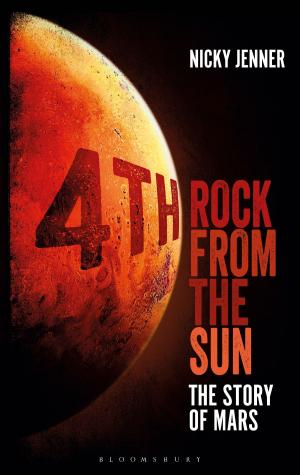Fast Things in the Solar System
Nonfiction, Science & Nature, Science, Physics, Astronomy, Astrophysics & Space Science| Author: | William Haloupek | ISBN: | 9781301083817 |
| Publisher: | William Haloupek | Publication: | December 31, 2012 |
| Imprint: | Smashwords Edition | Language: | English |
| Author: | William Haloupek |
| ISBN: | 9781301083817 |
| Publisher: | William Haloupek |
| Publication: | December 31, 2012 |
| Imprint: | Smashwords Edition |
| Language: | English |
Trying to get a sense of scale in the Solar System can be difficult, because the distances involved are outside the realm of ordinary experience. Planets and other bodies also move at much greater speeds than ordinary household objects. For example, 1 km/sec is pretty fast for a bullet, but slow compared to any of the planets. It would take you a very long time to get anywhere in the Solar System, moving at that speed. In order to get a sense of the speeds of things, let’s start with some familiar examples.
The fastest human, in terms of running speed, is Usain Bolt, who set the record in the 100 meter run on August 16, 2009. The record time was 9.58 seconds, for an average speed of 10.44 m/sec. The actual top speed of 12.27 m/sec occurred at about the 65 meter mark.
The world record for the standing high jump is 60 inches (1.524 m), set by Kadour Ziani. At the top of his leap, his center of mass was 1.524 meters higher than in standing position. To raise your center of mass that high, in normal gravity (9.8 m/sec2), you would need to leave the ground with a “launch speed” of about 5.5 m/sec. There is probably a lot of error in this estimate, partly because you don’t leave the ground flat-footed, and you’re not a point mass. However, I’m going to imagine a person jumping off an asteroid or moon with the same speed, so the same conditions apply. For simplicity, I call 5.5 m/sec the maximum jump speed. A pretty good athlete can probably launch themselves at 4 m/sec, and an average person, or perhaps an athlete wearing a cumbersome space suit, maybe 2 m/sec. This will be important later, when I describe jumping off a small moon or asteroid.
The fastest baseball pitch ever recorded by radar came in at 104.8 mph (46.85 m/sec). It was thrown by Joel Zumaya, for the Detroit Tigers, on October 10, 2006, in a game against the Oakland Athletics. Dozens of other pitchers have joined the 100 mph club, and it doesn’t seem likely that Zumaya’s record will hold for very long.
The fastest golf ball, hit by Jason Zuback, had speed 91.2 m/sec. (Your name doesn’t have to start with a Z to hold one of these records, but I guess it helps!)
The fastest insect is the Australian dragonfly, at 16 m/sec. It could outrun the fastest human! Fortunately, they don’t bite, and are actually harmless to humans. The fastest bird, in level flight, is the red-breasted merganser, at 36 m/sec. In a dive, the peregrine falcon holds the record, at 97 m/sec.
The Land Speed Record for race cars was set by the ThrustSSC on October 15, 1997. At 763 mph (341 m/sec), it was the first supersonic record. It would be hard to go any faster without actually leaving the ground! In fact, at such high speeds, the distinction between a car and an airplane becomes blurred. Having to keep contact with the ground just slows you down, and creates a safety hazard.
The speed of sound depends on the pressure, temperature and composition of the medium the sound is traveling in. In ordinary air, under ordinary conditions, the speed of sound is generally between 325 and 350 m/sec. The speed of sound in water is much higher: about 1500 m/sec in fresh water, and 1560 m/sec in salt water.
Trying to get a sense of scale in the Solar System can be difficult, because the distances involved are outside the realm of ordinary experience. Planets and other bodies also move at much greater speeds than ordinary household objects. For example, 1 km/sec is pretty fast for a bullet, but slow compared to any of the planets. It would take you a very long time to get anywhere in the Solar System, moving at that speed. In order to get a sense of the speeds of things, let’s start with some familiar examples.
The fastest human, in terms of running speed, is Usain Bolt, who set the record in the 100 meter run on August 16, 2009. The record time was 9.58 seconds, for an average speed of 10.44 m/sec. The actual top speed of 12.27 m/sec occurred at about the 65 meter mark.
The world record for the standing high jump is 60 inches (1.524 m), set by Kadour Ziani. At the top of his leap, his center of mass was 1.524 meters higher than in standing position. To raise your center of mass that high, in normal gravity (9.8 m/sec2), you would need to leave the ground with a “launch speed” of about 5.5 m/sec. There is probably a lot of error in this estimate, partly because you don’t leave the ground flat-footed, and you’re not a point mass. However, I’m going to imagine a person jumping off an asteroid or moon with the same speed, so the same conditions apply. For simplicity, I call 5.5 m/sec the maximum jump speed. A pretty good athlete can probably launch themselves at 4 m/sec, and an average person, or perhaps an athlete wearing a cumbersome space suit, maybe 2 m/sec. This will be important later, when I describe jumping off a small moon or asteroid.
The fastest baseball pitch ever recorded by radar came in at 104.8 mph (46.85 m/sec). It was thrown by Joel Zumaya, for the Detroit Tigers, on October 10, 2006, in a game against the Oakland Athletics. Dozens of other pitchers have joined the 100 mph club, and it doesn’t seem likely that Zumaya’s record will hold for very long.
The fastest golf ball, hit by Jason Zuback, had speed 91.2 m/sec. (Your name doesn’t have to start with a Z to hold one of these records, but I guess it helps!)
The fastest insect is the Australian dragonfly, at 16 m/sec. It could outrun the fastest human! Fortunately, they don’t bite, and are actually harmless to humans. The fastest bird, in level flight, is the red-breasted merganser, at 36 m/sec. In a dive, the peregrine falcon holds the record, at 97 m/sec.
The Land Speed Record for race cars was set by the ThrustSSC on October 15, 1997. At 763 mph (341 m/sec), it was the first supersonic record. It would be hard to go any faster without actually leaving the ground! In fact, at such high speeds, the distinction between a car and an airplane becomes blurred. Having to keep contact with the ground just slows you down, and creates a safety hazard.
The speed of sound depends on the pressure, temperature and composition of the medium the sound is traveling in. In ordinary air, under ordinary conditions, the speed of sound is generally between 325 and 350 m/sec. The speed of sound in water is much higher: about 1500 m/sec in fresh water, and 1560 m/sec in salt water.















